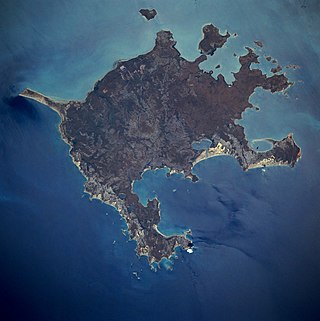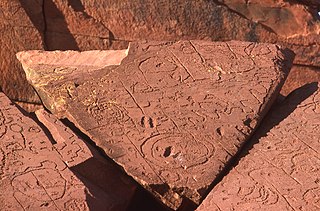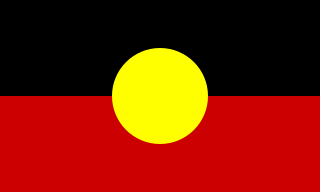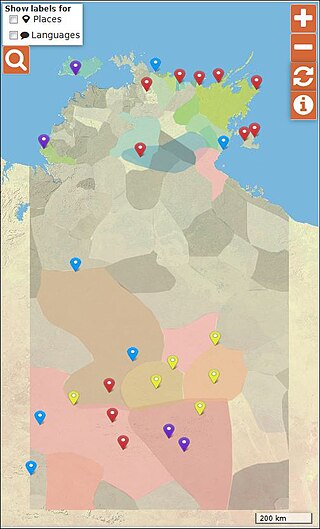Anindilyakwa may refer to:
- Anindilyakwa people, an ethnic group of Australia
- Anindilyakwa language, an Australian language
- Anindilyakwa Indigenous Protected Area, a protected area in the Northern Territory of Australia
Anindilyakwa may refer to:

Groote Eylandt is the largest island in the Gulf of Carpentaria and the fourth largest island in Australia. It was named by the explorer Abel Tasman in 1644 and is Dutch for "Large Island" in archaic spelling. The modern Dutch spelling is Groot Eiland.

The protected areas of the Northern Territory consists of protected areas managed by the governments of the Northern Territory and Australia and private organisations with a reported total area of 335,527 square kilometres (129,548 sq mi) being 24.8% of the total area of the Northern Territory of Australia.
APA most often refers to:

Arnhem Land is a historical region of the Northern Territory of Australia, with the term still in use. It is located in the north-eastern corner of the territory and is around 500 km (310 mi) from the territory capital, Darwin. In 1623, Dutch East India Company captain Willem Joosten van Colster sailed into the Gulf of Carpentaria and Cape Arnhem is named after his ship, the Arnhem, which itself was named after the city of Arnhem in the Netherlands.
The Central Land Council (CLC) is a land council that represents the Aboriginal peoples of the southern half of the Northern Territory of Australia (NT), predominantly with regard to land issues. it is one of four land councils in the Northern Territory, and covers the Central Australia region. The head office is located in Alice Springs.

Aboriginal Australians are the various Indigenous peoples of the Australian mainland and many of its islands, but excluding the ethnically distinct people of the Torres Strait Islands. The term "Indigenous Australians" is applied to Aboriginal Australians and Torres Strait Islanders collectively.

Anindilyakwa is an Australian Aboriginal language spoken by the Anindilyakwa people on Groote Eylandt and Bickerton Island in the Gulf of Carpentaria in the Northern Territory of Australia. Anindilyakwa is a multiple-classifying prefixing language in which all traditional nouns, adjectives, personal and demonstrative pronouns are prefixed for person, number and gender. According to the 2021 Australian Census, Anindilyakwa was spoken natively by 1,516 people, an increase from 1,283 in 2006.
Angurugu is a community located on Groote Eylandt in the Northern Territory, Australia. The main spoken languages are Anindilyakwa, an Australian Aboriginal language, and English. Established as a Mission for the Church Mission Society, it is one of the three main indigenous settlements on the Groote Eylandt archipelago alongside Milyakburra and Umbakumba. According to the 2016 Census, the community had a population of 855, a decrease from 882 in 2006.

The East Arnhem Region is a local government area of the Northern Territory, Australia, governed by the East Arnhem Regional Council. Situated in the far north-eastern corner of the Northern Territory, the region covers an area of 33,310 square kilometres (12,861.06 sq mi) and had a population of approximately 10,345 in June 2018.

An Indigenous Protected Area (IPA) is a class of protected area used in Australia; each is formed by voluntary agreement with Indigenous Australians, and declared by Aboriginal Australians and Torres Strait Islander representative organisations. Each is formally recognised by the Australian Government as being part of its National Reserve System. The areas may comprise land and sea, and are managed by Indigenous groups for the conservation of biodiversity. Managing IPAs also helps to protect the cultural values of their country for future generations, and has benefits for Indigenous health, education, economic and social cohesion.

Prince Regent National Park, formerly the Prince Regent Nature Reserve, is a protected area in the Kimberley region of Western Australia. In 1978 the area was nominated as a UNESCO World Biosphere Reserve.

The Arnhem Land tropical savanna is a tropical and subtropical grasslands, savannas, and shrublands ecoregion in Australia's Northern Territory.

The Macro-Gunwinyguan languages, also called Arnhem or Gunwinyguan, are a family of Australian Aboriginal languages spoken across eastern Arnhem Land in northern Australia. Their relationship has been demonstrated through shared morphology in their verbal inflections.
The Change at Groote is a 1968 Australian film which examined how the Anindilyakwa people of Groote Eylandt adjusted to the change in their lifestyle which resulted from the discovery of manganese on their land. The director and writer of the film described it as "a fragmented collage of images and sounds, intended to produce a direct emotional response" and "a study of a complete cultural revolution in less than a generation". It was produced by the Australian Commonwealth Film Unit.

The Living Archive of Aboriginal Languages (LAAL) is a digital archive of literature in endangered languages of Australia, containing works in over forty Australian Aboriginal languages from the Northern Territory, Australia. The project to build the archive was initially funded in 2012 by the Australian Research Council, and was developed in collaboration with the Charles Darwin University as the lead institution, the Northern Territory Government and the Australian National University. Later partners include the Batchelor Institute of Indigenous Tertiary Education, the Northern Territory Library and the Northern Territory Catholic Education Office.
Alyangula is the largest township on Groote Eylandt in the Northern Territory.

The Anindilyakwa people (Warnumamalya) are Aboriginal Australian people living on Groote Eylandt, Bickerton Island, and Woodah Island in the Gulf of Carpentaria in the Northern Territory of Australia.
The Nunggubuyu are an Aboriginal Australian people of eastern Arnhem Land in the Northern Territory.
Umbakumba is a community located on Groote Eylandt in the Gulf of Carpentaria, Northern Territory, Australia. The main spoken languages are Anindilyakwa, an Australian Aboriginal language, and English. There are also several Yolŋu Matha speakers. It is one of the three main settlements on the Groote Eylandt archipelago, including Milyakburra and Angurugu, where Anindilyakwa is the predominant spoken language. According to the 2016 Australian Census, the population of Umbakumba was 503, an increase from 441 in 2011.